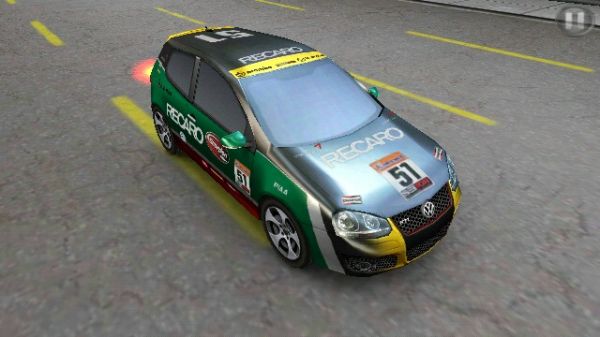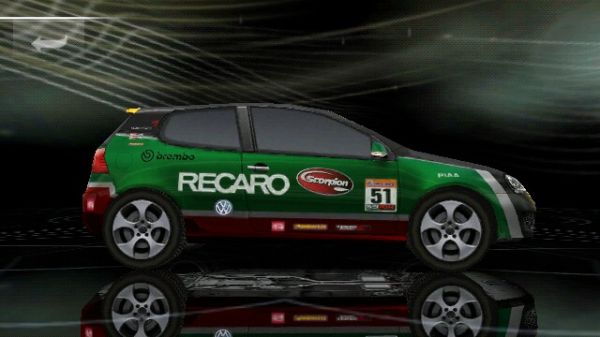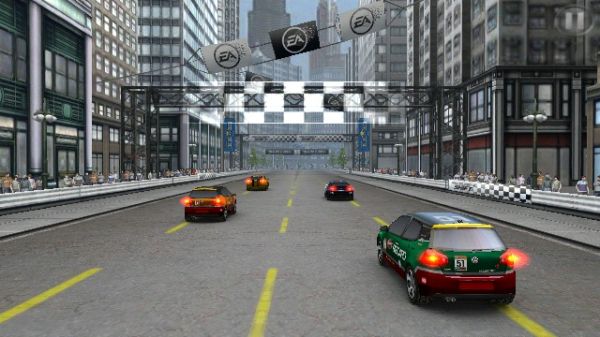Nokia N8 Review: Nokia's New Flagship
by Mithun Chandrasekhar on January 12, 2011 1:00 AM EST- Posted in
- Smartphones
- Nokia
- N8
- Symbian
- Mobile
Look who’s calling the shots…
The N8 represents many firsts for Nokia. It is the first phone to be based on the Symbian^3 platform. It is the first Nokia phone to carry a 12MP camera sensor. It is also the first Nokia phone to have a discrete GPU. And finally, it is the first mainstream Nokia phone to be multi-touch capable (and just the 2nd to have a capacitive screen) and have a GPU accelerated UI, both of which are as a result of switching to Symbian^3. And when it comes to the display and what’s driving it, the Nokia N8 doesn’t disappoint.


NFS Shift HD running on the BMC2727 in the Nokia N8
While I’ll get to the biggest change in the N8 that is the Symbian^3 OS in a while, Nokia has also updated what’s calling the shots behind the scenes. Up until Symbian^3 came along, Nokia rarely ever bothered with including a GPU in its phones and even when it did, it was never really put to any good use. Its last N-Series flagship, the N97, didn’t even have a GPU per se. Except for the Cortex A8-touting outlier that the N900 is, the best that Nokia has done in terms of integrating GPU’s into phones is make use of the OMAP 2420 SoC, which included a PowerVR MBX GPU, in a handful of its previous devices and even this was left mostly unutilized. Things have changed, for the better, with the Nokia N8. Although Nokia is still sticking with a tried and tested ARM 11 implementation for its CPU, it has actually gone ahead and made full use of a discrete Broadcom BCM2727 Multimedia processor for graphic duties. While you can see performance numbers later in the review, the general impression is that it is fairly competent as a GPU.
Nokia’s choice of using an aged ARM 11 implementation, down-clocked to 680 Mhz (instead of the spec’d 772 Mhz) for its CPU may draw criticism in this day and age of gigahertz-capable, multi-core mobile SoC’s. But digging a little deeper seems to show that there may be some method to this madness. You see, pretty much everything in the N8 runs around the BCM2727 media processor. I would hazard a calculated guess that apart from lightweight low-level OS functions and interfacing with the baseband and other radio’s, there isn’t much else for the CPU to do on the N8. Plus, Symbian’s inherently efficient use of available resources helps too.
So what was needed in this case was a low-power, package efficient CPU design that could just about get the job done while sipping as little power and occupying as little space as possible. And this is almost exactly what Nokia found in the Samsung K5WXXXXXXX series of Fusion Memory MCP’s. This MCP (Multi Chip Package) allows Samsung to stack different memory types (DDR, NAND etc.) along with non-memory logic in the same low-power package. So for basically the same footprint as a single memory chip, Samsung is able to integrate the DDR memory (256MB), NAND (512MB) and a CPU (TI ARM11 applications processor).
Most of the heavy lifting in the N8 is done by the BCM2727, as it renders the Symbian^3 UI and games alike, works with the camera module to capture and process 12MP stills and 720p videos, encodes/decodes those videos, drives the HDMI output (upto 720p) and even decodes the audio. So in case of the N8 and Symbian^3, it made sense for Nokia to have a low-power ARM11 CPU coupled with a reasonably powerful and competent multimedia processor. Using an A8 Cortex-based 1Ghz+ part here to run Symbian^3 would have been overkill and power-inefficient. And this decision is quite obvious when you use the N8. The UI is very fluid and responsive with crisp transitions and swift app switching. Furthermore, the N8 posted very competitive battery life numbers to further substantiate Nokia’s decision here.












119 Comments
View All Comments
Voldenuit - Wednesday, January 12, 2011 - link
"Mobile devices are service-enabling platforms, not software-execution platforms."BOOM-Tish! Somebody give this man a dollar, he's hit the nail on the head!
As mithun said in his review, if a faster processor does not enable more functionality, all it's doing is sucking more power.
Yes, we all want the latest and greatest, but it seems nokia made the smart move by focusing on the GPU and coupling it with a CPU that's just fast enough for its needs.
The 3GS was a marked improvement on the 3G in terms of speed and responsiveness, but the N8 is about as responsive as the 3GS using a much slower CPU because of its more compact/efficient OS and being smart about offloading to the GPU when needed. This is what fusion should be about.
anactoraaron - Thursday, January 13, 2011 - link
I do see your point, however every other phone manufacturer is always updating to the "latest and greatest" while still keeping power usage under control. ...how do they do this? tech as it evolves gets smaller- and I shouldn't need to explain moore's law to anyone here. The phone software shoud be optimized to the latest and greatest to take advantage of BOTH the speed AND power usage of the device.Selling the nexus one with eclair and reselling it a year later with gingerbread without improving anything from a hardware perspective is what I see Nokia doing here. All they have done is re-optimize symbian to offload as much work as possible to the gpu. But I would almost guarantee a faster cpu would speed up the browser. And then they would have to reoptimize that and the juggling act nokia has done here starts all over.
I wonder why the N900 isn't included with the benchmarks of this phone? Let's see... Sunspider benchmark... N900: 37816.... N8-00 (with opera 10- default browser is slower): 100029. So you can say "service-enabling platform" but if you're not optimizing the platform for commonly used tasks - AGAIN for a regularly executed function (web browsing, phone calls) than what are you optimizing it for? But Nokia decided that those thing weren't that important and while you get great battery life 3G browsing (wifi numbers will likely be similiar) - by sipping a slower cpu to save that battery life you get a HORRIBLE browsing experience.
I called this phone a "turd" because I view it as a step backwards from the N900 (the former and maybe still flagship Nokia phone) redesigned symbian and all.
'quote' but the N8 is about as responsive as the 3GS using a much slower CPU because of its more compact/efficient OS and being smart about offloading to the GPU when needed.
So you're saying that it's not as fast as the 3GS. This is their NEW flagship phone! And it's "about as responsive as a 3GS"- again a phone that's 1.5 years old! I simply want BETTER from Nokia to restart the "off contract" or "unlocked" market and this phone FAILS at doing so. I truly believe the N900 is a great phone! There are simply faster, much more responsive, longer battery life, all in all better phones out than this one (N8-00) right now.
Are they still planning on all but killing off symbian with meego (should it come out)? That would have to influence a purchase decision also.
Voldenuit - Thursday, January 13, 2011 - link
iPhone4 isn't faster than 3GS either. In fact, in some benchmarks, it's slower (because of the higher resolution display).3GS was significant because its speedup over the older models represented a milestone in device responsiveness and user expectations.
A phone which is faster than the 3GS would probably go unnoticed among many users, but one which is significantly slower would not be accepted.
The N8 is definitely snappy enough to fall into the first camp.
While AT is a tech site and its phone reviews are understandably geared towards the technical details and specifications of the chips that go into the phones, hardware specs are not the be all and end all of a smartphone. For most smartphone tasks, the N8 is quite up to the job.
Yes, the browser is in definite need of improvement, I'm using Opera Mobile on it right now and even that is not fantastic, but it's enough for my purposes as the other advantages of the N8 (GPS, pentaband 3G, camera) outweighed it over the current crop of Android and iOS devices for my specific needs.
ojisama - Sunday, January 16, 2011 - link
I guess you didn't read the part about GPU. "Most of the heavy lifting in the N8 is done by the BCM2727". "Using an A8 Cortex-based 1Ghz+ part here to run Symbian^3 would have been overkill and power-inefficient."dagamer34 - Thursday, January 13, 2011 - link
As snappy as the 3GS except the 3GS is almost TWO YEARS OLD.AssBall - Thursday, January 13, 2011 - link
Funny, since most contracts are for TWO YEARS.Not every idiot gets a new phone every 6 months. Nokia has always been especially good at call quality, above other stuff. You know, in case you actually use your phone to CALL PEOPLE instead of some kind of nerdwit multimedia toy.
Exodite - Wednesday, January 12, 2011 - link
While is has its issues to be sure, the browser being one of them, it's actually an awesome device as soon as you consider the phone implications.Audio quality is excellent and reception better than any handset I've used. The camera really deserves even more praise as it's not just better than those offered by current high-end smartphones but entirely in a league of its own.
Then there's the many convenient features like USB-on-the-go, BT keayboard and mouse connectivity, FM transmitter, 5.1 audio output, native DivX and MKV support etc.
My better half has one and running 3G and Wi-Fi enabled 24/7, live Twitter feeds and gmail updates through widgets, as well as snapping shots with the Xenon flash and playing the odd games she still gets about 3 days worth of battery out of the device.
It's awesome, as long as you want a phone with media functions and not the other way around.
That's not to say it's perfect but all the issues are really related to software and we can only hope Nokia takes fixing them to heart. Indeed, the only hardware omission I find annoying is a LED lamp for video and use as a torch.
Funny as it may sound I've actually come to rely on using my phone as a torch.
I have to say that I expected a bit more from this review, RightMark Audio Analyser tests, reception and signal strength tests, a more detailed look into the camera and image quality options.
That's not to say it's a bad review, only that the real strengths of this handset aren't immediately obvious to the same extent that its flaws are.
Voldenuit - Wednesday, January 12, 2011 - link
"The camera really deserves even more praise as it's not just better than those offered by current high-end smartphones but entirely in a league of its own."Yes. It's 6 times bigger than the sensor on the iPhone4. SIX TIMES!!!
Something to chew on for a while.
Re: LED torch functionality, I can understand why it's missing (compared to previous nokias) because the Xenon flash is not designed for continuous output and the AF assist lamp is red (although I actually prefer the red setting on my 3rd party torch app to preserve nightvision in the dark).
I also notice that signal attenuation tests are missing from this review - maybe that's due to technical issues in measuring gain from the antenna?
Agreed that it's easier to point out the flaws than the strengths - the whole is better than the sum of its parts, because while all smartphones have their strengths, the N8 is very well balanced in its abilities. Some phones might do X or Y better, but the N8 excels at doing nearly everything consistently well (push email support aside, which is coming, and which has workarounds) and does some things (like Bluetooth 3, FM transmitter) that other phones don't even try to.
melgross - Wednesday, January 12, 2011 - link
Awesome? Yeah, in mid 2009. Right now, the only thing that's awesome about this is that it's their top model, considering how backwards it it.All I can get from this review is that it's ok in most areas, not so hot in the others, and has a camera that's batter than in other phones but not so great when compared to dedicated compacts. That is, if you know something about photography.
Exodite - Wednesday, January 12, 2011 - link
Which is why I expected a more in-depth review in the first place.The N8 is priced like a mid-range smartphone but offer a lot of non-obvious advantages to the competition.
In my personal experience:
* Call/audio quality.
* Reception.
* Build quality/toughness.
* Battery life.
* Camera.
* Features (USB OTG, BT mouse/keyboard, FM transmitter, DivX/MKV playback, free GPS navigation with no roaming fees etc.)
* Design (like the two-stage dedicated camera button, hardware screen-lock snap-slider, lock-screen clock etc.)
Granted, it's not a handset for everyone but what is?
My ideal phone would be a Nokia design with Samsung electronics and HTC software and services but until that surfaces we have to make compromises. :)
In the case of Nokia those compromises are software related, like the browser and inconsistent services.
I could find equally serious issues with other high-end handsets, like the Desire HD and iPhone 4, but that doesn't mean that those devices don't deserve to be called 'awesome' as well.